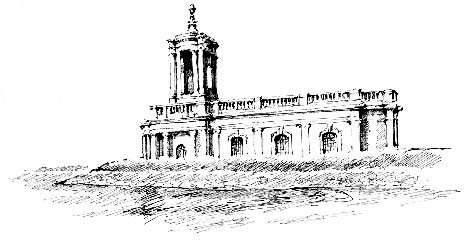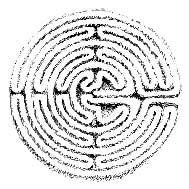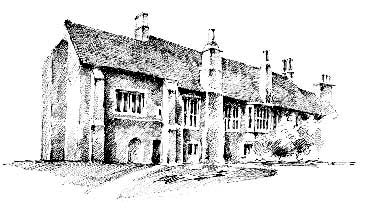Rutland
AMAZING ∗ THE POX
Normanton Church, a much loved landmark of England’s smallest county.
RUTLAND FOLK
Sir Gilbert Heathcote ∗ Canon Hardwicke Rawnsley ∗ Ernest Hornung ∗ Sir Malcolm Campbell ∗ William Pratt ∗ John Schlesinger
∗ Rick Stein ∗ Stephen Fry
Wing Maze
The pleasant village of WING sits on the brow of a hill with a view over Rutland Water to the north. There are plenty of interesting old houses and an old hall, and on the edge of the village is the superbly preserved WING MAZE, one of eight surviving English turf labyrinths.
Described in 1846 as ‘an ancient maze, in which the rustics run at the parish feast’, the Wing Maze measures 46 ft (14 m) across and is made up of paths that wind round to a centre in a series of decreasing circles, between low banks made of turf. The maze is a medieval English reproduction of the Cretan labyrinth constructed by Daedalus, father of Icarus who flew too close to the sun, and was devised by the Church as a form of penance. Wrongdoers were placed in the centre and had to make their way out on their knees, stopping at certain points to say prayers and meditate.
Liddington
Carved out of the wing of a medieval palace of the Bishops of Lincoln, the picturesque LYDDINGTON BEDE HOUSE was converted by Sir Thomas Cecil into an almshouse for 12 poor ‘bedesmen’ over 30 years old, and two women over 45, all ‘free of lunacy, leprosy or the French pox’.
Well, I never  knew this
knew this
about
RUTLAND FOLK
Sir Gilbert Heathcote
1652–1733
SIR GILBERT HEATHCOTE, the builder of Normanton Hall, of which only the clock tower and stable block survive, on the edge of Rutland Water, was one of England’s most successful merchants and an early pioneer of free trade, who took on and defeated the richest monopoly of them all, the East India Company. In 1693, Heathcote bought a ship called the Redbridge, filled her with cargo and prepared her to sail for Alicante. The East India Company, which ruthlessly protected its monopoly of Far East trade, immediately ordered the arrest of the Redbridge, while it was still anchored in the Thames, and the confiscation of her cargo. While the Company could get away with this on the High Seas away from the eyes of Westminster, such high-handed behaviour at the heart of London caused outrage, and when Heathcote stood up in Parliament to denounce the action, the arrest was declared illegal and a resolution passed declaring that no one could be restricted from trading unless specifically prohibited by law.
Heathcote went on to become a founding director of the Bank of England and twice its Governor. He was also elected Lord Mayor of London, and during the Lord Mayor’s procession he was unceremoniously thrown from his horse, when it was startled by a drunken gypsy girl. As a result it was decided that in future the Lord Mayor should make the journey by coach so as to ‘maintain his civic dignity’.
Sir Gilbert Heathcote was buried in the church at NORMANTON, which was rebuilt in the early 19th century to resemble St John’s, Smith Square, in London. When England’s largest man-made lake, Rutland Water, was created in the 1970s, the church was below the high water line and at risk of drowning. In order to save it the floor was raised by 10 ft (3 m) and the lower half of the building was filled with rubble, while a stone embankment was constructed around the church, along with a causeway for access. The Heathcote coffins and memorials, including one to Sir Gilbert by Rysbrack, were removed to the church in Edith Weston.
Normanton’s church today appears to be sailing on the water and forms a memorable and picturesque tourist attraction. Sir Gilbert Heathcote, the ultimate entrepreneur, would be proud.
Duke of Rutland
The first Earl of Rutland was Edward Plantagenet, grandson of Edward III and son of the Duke of York. The Earldom remained a title of the House of York until it eventually passed to Thomas Manners, son of Richard Plantagenet’s granddaughter Anne St Leger, in 1525, and the title has stayed in the Manners family to the present day. In 1703 the 9th Earl was made Duke of Rutland and Marquess of Granby. John Manners, Marquess of Granby and son of the 3rd Duke, was a celebrated soldier whose name is commemorated by numerous English pubs.
The Duke of Rutland’s main homes are Belvoir Castle in Leicestershire and Haddon Hall in Derbyshire.
Uppingham
Noted alumni of Rutland’s most famous school, Uppingham College, are known as Uppinghamians and include:
CANON HARDWICKE RAWNSLEY (1851–1920), co-founder of the National Trust.
ERNEST HORNUNG (1866–1921), author and creator of A.J. Raffles, ‘gentleman thief’.
SIR MALCOLM CAMPBELL (1885–1948) and his son DONALD (1921–67), world speed record holders on land and water.
WILLIAM PRATT (1887–1969), better known as Frankenstein actor BORIS KARLOFF.
JOHN SCHLESINGER (1926–2003), film director.
RICK STEIN, TV chef and restaurateur, born 1947.
STEPHEN FRY, actor, writer and TV presenter, born 1957.







 knew this
knew this